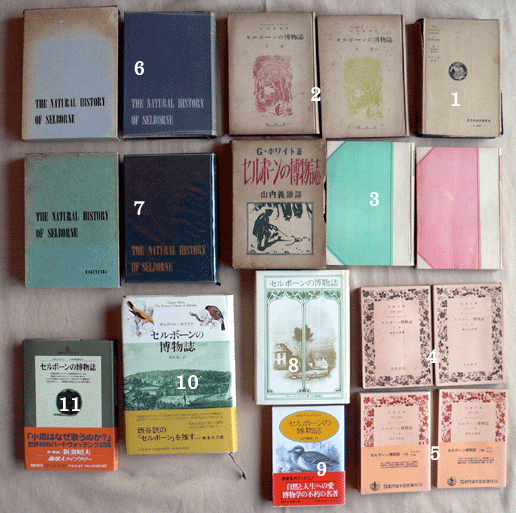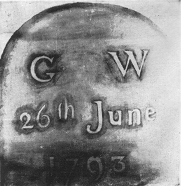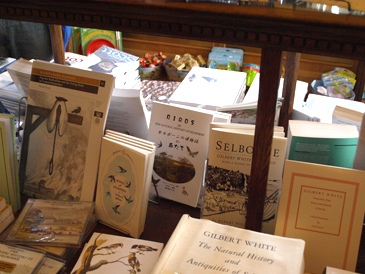<日英2ヶ国語併記 Japanese-English Bilingual Page>
セルボーン案内
A GUIDE TO SELBORNE
6. 『セルボーンの博物誌』 日本語版
2010年4月改訂
AN INTRODUCTION TO JAPANESE VERSIONS OF
"THE NATURAL HISTORY OF SELBORNE"
revised in April 2010
Selborne Top Dream Nursery
 |
①市河三喜の注釈本 ②山内義雄の養徳社昭和23年版 ③山内義雄の
養徳社版昭和24年版 ④寿岳文章の岩波文庫版 ⑤寿岳文章の岩波文
庫復刻版 ⑥西谷退三の私家版 ⑦西谷退三の博友社版 ⑧山内義雄の
出帆社版 ⑨山内義雄の講談社学術文庫版 ⑩西谷退三の八坂書房版
⑪新妻昭夫の小学館地球人ライブラリー版 |
①Ichikawa-Sanki's textbook edition ②Yamauchi-Yoshio's Yotokusha
1948 edition ③Yamauchi-Yoshio's 1949 edition ④Jugaku-Bunsho's
Iwanami Poket Library edition ⑤Jugaku-Bunsho's Iwanami Pocket Library
reprinted edition ⑥Nishitani-Taizo's private edition ⑦Nishitani-Taizo's
Hakuyusha edition ⑧Yamauchi-Yoshio's Shuppansha edition
⑨Yamauchi-Yoshio's Kodansha Accademic Pocket Library edition,
⑩Nishitani-Taizo's Yasakashobo edition ⑪Niidzuma-Akio's Shjoggakan
Global People's Library edition |
日本で『セルボーンの博物誌』が本として世に出るまでに、何人かの学者によって雑誌などで紹介されたり抄訳されたもの、後には原文に註を付けた教科書版がありました。昭和13
(1938) 年、柏倉俊三が抜粋したテクスト版を開隆堂から出しています。しかし、この本に言及されたものは皆無です。存在自体が疑わしかったのですが、第3版が西谷文庫(西谷退三の蔵書)の中に第3版があるのが見つかりました。初版はまだ見つかっていません。
昭和15 (1940) 年には市川三喜による完全テクスト版が注釈を付けて研究者英文学叢書の1冊(1)として出版されました。この本は少なくても後の2人の学者の翻訳に影響を与えています。
In Japan some shcolars publised introductory
essays or selected translations and later textbook editions of "THE NATURAL HISTORY OF SELBORNE". In 1938 an abbreviated textbook with notes was published by Kashiwagura
Shunzo from Kairyudo in Tokyo. But even the name of the textbook had never
reffered to in any articles concerned. The existence istself had been dubious,
but the third editon of it was found in Nishitani Library (Nishiani-Taizo's
library). The first editon is yet to be found.
In 1940 Ichikawa-Sanki's full text version
was published as one of the Kenkyusha English Literary Series (1). It gave
much help to at least the two scholars who completed their full translation
later.
昭和23(1948)年になって日本で最初の完訳が山内義雄の訳で奈良県の養徳社から2卷本(2)で出版されました。山内義雄は昭和18
(1943)年には翻訳を完成させていましたが、その出版は戦後まで待たねばならなかったのです。次の年に第2版(3)が箱入りになって出版されています。昭和51(1976)年には出帆社から1卷本(8)として出版されましたが、彼はこの新しい本を目にすることはできませんでした。ついで平成4(1992)年に講談社から図版入りで講談社学術文庫の1冊(9)として出版されました。残念ながら山内義雄の本は全て絶版になっています。
昭和24(1949)年には寿岳文章による翻訳で岩波文庫版(4)が出版されました。それもまた2卷に分かれています。彼もまた既に戦前に抄訳を雑誌に発表していました。
It was in 1948 that the first complete translation
into Japanese was published in two volumes by Yamauchi-Yoshio from Yotokusha
in Nara Prefecture (2). He had finished his translation in 1943,
but the war prevented the publication. His second edition (3) appeared
in the next year from the same publisher, but the two volumes were set
in a cardboard box with a picture on it. In 1976 his translation
was published in one volume by Shuppansha (8), but alas, he could not see
his new edition. And in 1997 it was republished with illustrations by Kodanasha
as one of the Kodansha Accademic Pocket Library Series (9). Unhappily all
his editons were out of print now.
The next one was published in 1949
by Jugaku-Bunsho as one of the Iwanami Pocket Book Library Series (4).
It was also divided into two volumes. And he also had published some translations
of selected chapters in a magazine. In 1977 it was reprinted in commemoratation
of the 50 years of the Iwanami Pocket Book Library Series (5).
3番目のもの(6)は昭和33 (1958) 年に高知県の小さな町・佐川で出版されました。先の2つの訳本の著者は共に大学教授でしたが、この本の著者は西谷退三といい、死後にその本が出版されるまで世には知られなかった人でした。私家版としてわずか200部しか出版されなかったその本が注目されて、3年後の昭和36
(1961) 年には市販本が東京の博友社から出版(7)されました。平成4 (1992) 年には八坂書房から図版も新たな註も加えれたものが出版(10)されました。
The third one (6) was published in 1958
at a small town, Sakawa, in Kochi Prefecture. Although the authors of the
former two were professors, the third man Nishitani-Taizo was a man unknown to the world until his translation was published after his death.
Althoug only 200 copies were printed then as a private edtion, the book
attracted much attention of the world. Three years later, in 1961, the
marketplace edition (7) was published by Hakuyusha in Tokyo. In 1992 a
completely new edition with illustrations and new notes was published by
Yasaka Shobo in Tokyo (10).
平成9(1997)年に新妻昭夫の訳が「小学館地球人ライブラリー」の1冊(11)として出版されました。しかし、これは完訳ではありません。多くのページが割愛され編集されています。手に入りやすいし入門書としてはいいと思います。
In 1997 Niiduma-Akio's translation was published
as one of the Shogakkan Global People's Library Series (11). But it is
not a complete translation. Many pages are omitted and edited by the translator.
However, it is easy to get and may be useful for beginners to natural history.
平成20 (2008) 年末に BIRDS OF THE NATURAL HISTORY OF SELBORNE 『セルボーンの博物誌の鳥たち』 という日英対訳版が編訳・井沢浩一/絵・黒田萬知子で生態系トラスト協会から出版されました。左側のページに原文に現れる野鳥全部のイラストを載せ、大きさ・現代の英名と和名も添えています。右側のページの上段にはその鳥が出てくる原文を載せ下側に新たな日本語訳と註などを加えています。原文も味わえる訳本としては世界初といってもいいでしょう。野鳥が主なページを占めていますが、原本の全体像や訳本や訳者のこと、現代のセルボーン案内や参考書目も載っていて入門書としても役立つと思います。英文学を読む場合の野鳥図鑑にもなります。
At the end of 2008 an English and Japanese
bilingual book "BIRDS OF THE NATURAL HISTORY OF SELBORNE" was published by Izawa-Koichi and Kuroda-Machiko from the Ecosystem Trust
Society. On the left pages all the birds whch appears in the original text
are drawn with their modern English and Japanese names. On the right pages
the sentences abstracted from the original text and the Japanese translations
were put togeher with some notes. The main part is about the birds of the
original text, but you can grasp the whole image of the original book with
the intorductory pages, the bibliography and a guide to Selborne. It will
also useful for lovers of English literature as illustrated book of birds.
山内義雄(やまうちよしお)について
About Yamauchi-Yoshio(1905-1963)
松山市生まれ。東大卒。英文学者。明治大学教授。*同じ字を書く「やまのうちよしお」は仏文学者。
He was born in Matsuyama City and graduated
from Tokyo University. He lectured English literature at Meiji University.
*Be careful not to take him as scholar in French lieterature, Yamanouchi-Yoshio.
西谷退三 小伝
A Brief Biography of Nishitani-Taizo
西谷退三こと竹村源兵衛は明治18 (1885) 年に高知県の佐川で生まれました。札幌農学校予科に進学していましたが、2年の修了を待たずに帰郷しました。有力な薬問屋の跡取り息子でしたので父の跡を継がねばなりませんでした。しかし、商売には関心がなく仕事はほとんど番頭や叔父に任せて生涯を趣味に生きた人でした。
Takemura-Genbei (1885-1958), alias Nisitani-Taizo, was
born in Sakawa, Kochi Prefecture. He advanced to the Preliminary Course
to Sapporo Agricultural College in Hokkaido, but left the school before
he finished his second year. He wa a heir to a rich medicine wholesaler
and had to succeed to his father. But his interest was not in business.
Trusting his work to his manager and uncle, he dovoted himself to his various
hobbies all through his life.
大正12(1923)年に高知を離れてアメリカへの旅に出ました。各地を巡りながら1年3ヶ月をかけてサンフランシスコからニューヨークまで旅しましたが、彼が特に関心があったのはエマソンやソローが住んでいたコンコードでした。そこへは何度も訪れてたくさんの写真や絵はがきを叔父・仁作(にさく)に送っています。翌年3月末に大西洋を渡りました。ロンドンでの彼の目的はイギリスの家庭生活を体験することでした。幸いにもいい下宿がロンドン市内の北部のセント・ジョーンズ・ウッドで見つかりました。そこで家主の家族との生活を楽しみながら8ヶ月を過ごしました。ダービーへ行ったり、音楽会や観劇にも出かけ社会生活も十分に楽しみました。大英博物館へは何度も足を運んでいます。本の虫でしたのでロンドン中のほとんどの本屋へも出かけて多くの本を買っています。ロンドンは離れたのは約1ヶ月のパリからジュネーヴへの旅とセルボーンへ2度の日帰り旅行をした時だけでした。その頃はギルバート・ホワイトよりもジャン・ジャック・ルソーに興味があったように思えます。叔父や友人達への手紙の中にはセルボーンの名前すら出て来ないのです。
In January 1923 he left Kochi for the USA. He travelled from San Francisco
to New York for 15 months visiting various noted places, but the most attractive
place for him was Concord where Emerson and Thoreau had lived. He visited
there many times and sent a lot of photographs he took and postcards to
his beloved uncle, Nisaku. At the end of March in 1924 he crossed the Atlantic.
What he wanted to do in England was to experience a life there. Luckily
he found a favourable lodging house at St John's Wood in the north of London.
He stayed there for 8 months and enjoyed his life with the family of the
landlord. He enjoyed even a social life there, visiting Derby, theatres
and concert halls. He spent much time at the British Museum. He was a bookworm
and went to almost all the bookstores in London and bought many books.
He did not leave London except for one month travel from Paris to Genova
and twice of one-day visit to Selborne. It seems he had more interest in
Jean-Jacques Rousseau than Gilbert White at that time. In his letters to
his uncle and friends, he never mentioned evnen the name of Selborne.
 |
西谷退三が採って来た
ギルバート・ホワイトの
墓石の拓本
Rubbing of Gilbert
White's gravestone
made by Nishitani |
彼が『セルボーンの博物誌』に特に興味を持ったのは帰国してからではないかと思います。その頃にはまだ日本でその本を知っている人は彼以外にはほとんどいませんでした。初めて日本に紹介されたのは昭和3年(1928)のことでした。その後に英文学の専門誌でもぼつぼつ紹介されるようになったのです。翻訳された本などはありませんでした。
His special interest in "THE NATURAL HISTORY OF SELBORNE" must have been after his coming home. At that time in Japan almost no
one besides him knew even the existence of the book. It was not until 1928
that the book was first introduced to Japan. After that the name of the
book and selected translations began to appear on some magazines for English
scholars and students. There were no translated books.
それで自分がやってみようと思ったのでしょうが、実際に翻訳を始めたのは昭和14年(1939年)ごろのようです。そして原稿は昭和21
(1946) 年にはほとんど完成していました。しかし、戦後の農地改革の影響もあって彼の出版の意図は果たせませんでした。ついに山内義雄が本邦初の翻訳を出版し、寿岳文章もこれに続きました。そして昭和32
(1957) 年6月、とうとう夢は果たせぬまま死を迎えねばなりませんでした。
This may be the reason why he tired to translate
it into Japanese, but it was at the ealiesy in 1939 that he really began
his work. The draught was completed at the latest in 1946. After the war
Yamauchi-Yoshio and Jugaku-Bunsho successively published their translation,
but the land reform after the war had put him in a difficult condition.
At last he had to meet his last day in June, 1957, without realising his
dream.
2005.2.26. 2010年4月9日改訂
このページのトップへ
to the top of this page
「残された名訳」 AN EXCELLENT TRANSLATION LEFT
Selborne-5
Selborne-4
Selborne-3
Selborne-2
Selborne-1
Selborne Top


